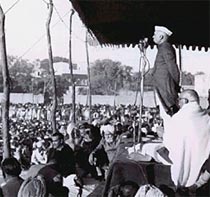

 |  |
 Democracy took a giant step forward with the first general election held in 1951-52 over a four-month period. These elections were the biggest experiment in democracy anywhere in the world. The elections were held based on universal adult franchise, with all those twenty-one years of age or older having the right to vote. There were over 173 million voters, most of them poor, illiterate, and rural, and having had no experience of elections. The big question at the time was how would the people respond to this opportunity. Democracy took a giant step forward with the first general election held in 1951-52 over a four-month period. These elections were the biggest experiment in democracy anywhere in the world. The elections were held based on universal adult franchise, with all those twenty-one years of age or older having the right to vote. There were over 173 million voters, most of them poor, illiterate, and rural, and having had no experience of elections. The big question at the time was how would the people respond to this opportunity.Many were skeptical about such an electorate being able to exercise its right to vote in a politically mature and responsible manner. Some said that democratic elections were not suited to a caste-ridden, multi-religious, illiterate and backward society like India's and that only a benevolent dictatorship could be effective politically in such a society. The coming elections were described by some as 'a leap in the dark' and by others as 'fantastic' and as 'an act of faith.' India's electoral system was developed according to the directives of the Constitution. The Constitution made a provision for an Election Commission. It was to be headed by a Chief Election Commissioner, to conduct elections. It was to be independent of the executive or the parliament or the party in power. Organization of the elections was a wondrous task. There was a house-to-house survey to register the voters. With over 70 per cent of the voters being illiterate, the candidates were to be identified by symbols, assigned to each major party and independent candidates, painted on the ballot-boxes (this was later changed to symbols on the ballot papers). The voters were to place the ballot papers in the box assigned to a particular candidate, and ballot was secret. Over 224,000 polling booths, one for almost every 1000 voters, were constructed and equipped with over 21/2 million steel ballot-boxes, one box for every candidate. Nearly 620,000,000 ballot papers were printed. About a million officials supervised the conduct of the polls. Of the many candidates, whoever got the plurality, or the largest number of votes would be elected. It was not necessary for the winning candidate to have a majority. In all, candidates of over fourteen national and sixty-three regional or local parties and a large number of independents contested 489 seats for the Lok Sabha and 3,283 seats for the state assemblies. Of these, 98 seats for the former and 669 for the latter were reserved for the Scheduled Castes and the Scheduled Tribes. Nearly 17,500 candidates in all stood for the seats to the Lok Sabha and the state legislatures. The elections were spread out over nearly four months from 25 October 1951 to 21 February 1952. (Later this period was reduced to nineteen days in 1957 and seven to ten days in subsequent elections). Suitable conditions were created for the free participation of the opposition parties in the elections, including Jan Sangh and CPI. The Opposition was, however, quite fragmented. 'The first general elections were marked by a vigorous election campaign by Jawaharlal Nehru. Showing remarkable energy, he covered nearly 40,000 kilometers and addressed thirty-five million people or a tenth of India's population during his election tour. |
Copyright ©2000 indiansaga.info. All rights reserved.
By using this service, you accept that you won't copy or use the data given in this website for any commercial purpose.
The material on indiansaga.info is for informational & educational purpose only.
This site is best viewed at 800 X 600 picture resolution.